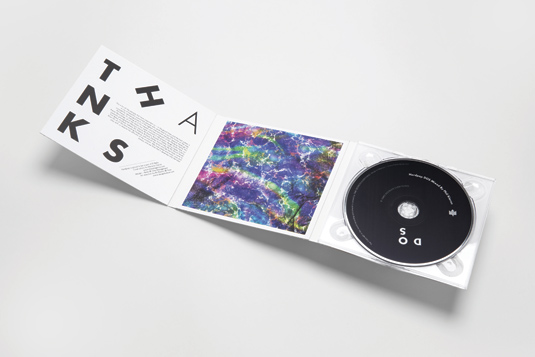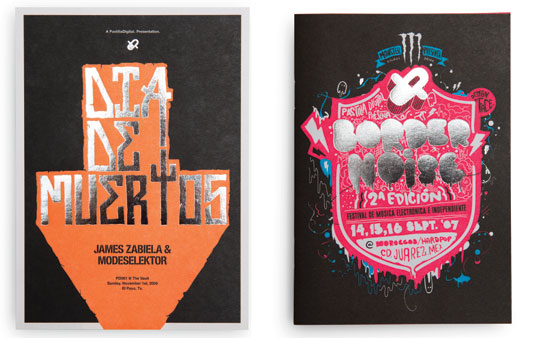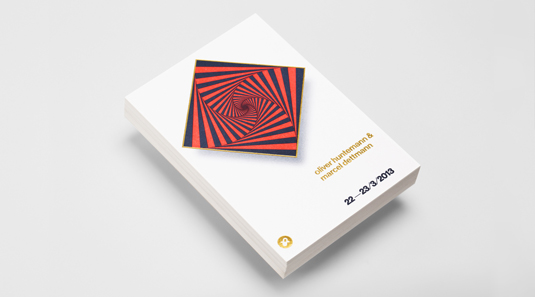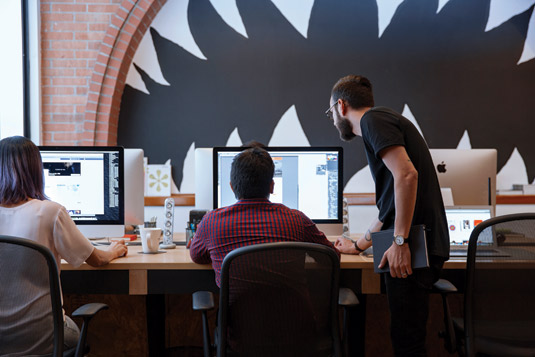How design is changing lives in one of the world’s deadliest cities
Last night a DJ saved your life? For music-obsessed Mexican studio Face, design can transform lives too.
Nestled inside a north Mexican shopping mall, in one of the world's deadliest cities, Hardpop is an unlikely venue for one of the best nightclubs on the planet. Yet each weekend the world's biggest producers arrive at the volatile desert town of Ciudad Juárez to play to packed-out crowds inside its unassuming walls.
For many, Hardpop is a haven in the centre of Mexico's violent drug war. But there's more to entrepreneur Ricardo Tejada's world-class nightspot than hedonism: where music provides sanctuary from the threat of violence outside, design offers an alternative pathway for a new generation of young creatives.
For almost a decade, Monterrey-based design studio Face has worked with Tejada's other business, event promotion firm Pastilla Digital, to produce a stunning, ever-expanding collection of experimental print collateral for Hardpop.

Utilising different materials, inks and finishes, it's an innovative body of work that has heavily influenced graphic design in northern Mexico and inspired a wave of local young people into the field. Indeed, one of those has gone on to become the studio's youngest partner and art director, Aaron Dominguez.
"It's perhaps the most influential work we've done in Mexico," reflects creative director Rik Bracho, who started designing posters and flyers for Pastilla Digital back in 2002, four years before launching Face.
Influential design
"Hardpop did a lot for Ciudad Juárez," agrees Dominguez, who graduated from the University of Texas in 2010 and has been working at Face's studios ever since. "It was a big influence for kids like myself. The project proves that good design can change people's lives, and it holds a really special place for me."
The project also has a special place for Bracho. He credits Hardpop as the catalyst behind the birth of Face, which he launched with fellow Pastilla Digital freelancers Hugo Campuzano and Mero Pavlovich in late 2006. A few weeks later Hardpop's Tejada also joined the studio, taking the team to four and balancing the creatives with his business focus.

Since then, Face has grown to nine – Pavlovich has moved on, and art director Campuzano has returned after a three-and-a-half-year hiatus – but Face retains a tight-knit feel. "We like it that way," explains Bracho. "We consider it a second family. We've evolved into a structured team of young talent, in a proper office, making projects for clients all over the world."
Now in its eighth year, Face has all manner of design work under its belt, from branding and advertising to packaging and custom publishing – including two print magazines: Pages and P Magazine.
The studio's portfolio oozes with attitude, sparking a bold dialogue between tight craft and stimulating visuals. Smart logotypes sit alongside strong typography and stark layouts, while classy print finishes add a further kick.
Supermodernism
Underneath it all lies a deep commitment to simplification. "Simplicity works," explains Campuzano. "Our style involves taking a strong concept and translating it as boldly and simply as possible into a clean, effective aesthetic."
Bracho agrees: "We try to simplify our process, our communication, our style and our work in general. It's not easy doing simple things, but we believe it's the best way of communicating a message."
To do so, the creatives apply a method they refer to as 'supermodernism' to all new commissions. This involves stripping away the layers to solve each design problem in the best possible way. Often, says Bracho, this translates into a minimalist aesthetic; but not always, as attested by the studio's vast portfolio of print for Pastilla Digital or last year's kaleidoscopic Caribbean Culture Festival identity.

One of the primary ingredients in the studio's supermodernist creative process is logic. Nowhere has this rational approach been more clearly effective than during a recent pivotal website redesign for Diverza, Mexico's leading electronic invoice service provider. Following a number of meetings with the client, Face realised that Diverza needed a more comprehensive redesign than the company had originally sought from the studio.
To help Diverza become more user-friendly, the studio proposed a new, stripped-back identity, combining illustrative elements with a warm logotype and a carefully considered colour palette to distil a sense of accessibility, reliability and efficiency into the brand, without being overly corporate.
"The design was just a translation of the message they wanted to communicate," Bracho reasons. "But the new graphic identity really revolutionised their philosophy, using the concept of simplicity to the max. They're still our clients now – they trust us to put their needs first."
Attention to detail
Despite the studio's multidisciplinary proficiency, identity and editorial design are Face's strongest suits; mainly, Bracho suggests, "because we love those little objects and documents that decorate our lives and spaces".
Indeed, this philosophy is proudly on show within the studio's charming brick headquarters: a stroll around the property reveals a collection of inspiring knickknacks that share corners and shelfspace with design classics such as the team's Eames Molded Plywood chair or Massimo Vignelli calendar, while photos and prints by both friends and team members adorn the walls. Visitors never fail to notice the huge, teeth-shaped monochrome mural on the far wall, which only adds to the studio's unique character.

The neighbours aren't bad, either. Face is based in Monterrey's affluent San Pedro district – a tree-lined neighbourhood speckled with parks, restaurants, museums and art galleries, not to mention being home to some of Latin America's finest design exports. Savvy Studio is just down the road and a little further away is Anagrama, Mexico's creative firm de l'heure. "We're all part of a generation of designers that grew up and even studied together in the city," explains Campuzano.
Northern Mexico's burgeoning design scene is being amply fuelled by increasing numbers of world-class studios like Face that are setting up and producing fresh, innovative creative for a global client base. It's an exciting time indeed for the local design community, which little more than a decade ago consisted of just a few dozen firms.
Healthy competition
With design flourishing in Monterrey, competition between studios is healthy. For Face, one of the biggest challenges is staying true to its 'less is more' supermodernist philosophy – particularly with local clients. "In Mexico, clients usually want the opposite of our motto: they want 'more design'," laughs Face's senior designer Ivan Pedroza. "Convincing them that we're on the right path isn't always an easy task."
But business is booming. Currently, Face is busy working on a wide variety of projects for clients ranging from international record labels to local real estate companies. And you can count on seeing more inspirational branding and print collateral for Ciudad Juárez's world-leading nightclub Hardpop, too.
"Supermodernism is more than a specific design style," asserts Branco. "It's an attitude. We still believe that design can change the world – or at least make it better."
Photography: Mariana Garcia
This article first appeared in Computer Arts issue 232, a design education special packed with insight, inspiration and behind-the-scenes access to the world's most exciting creative minds.

Thank you for reading 5 articles this month* Join now for unlimited access
Enjoy your first month for just £1 / $1 / €1
*Read 5 free articles per month without a subscription

Join now for unlimited access
Try first month for just £1 / $1 / €1
Get the Creative Bloq Newsletter
Daily design news, reviews, how-tos and more, as picked by the editors.

Julia is editor-in-chief, retail at Future Ltd, where she works in e-commerce across a number of consumer lifestyle brands. A former editor of design website Creative Bloq, she’s also worked on a variety of print titles, and was part of the team that launched consumer tech website TechRadar. She's been writing about art, design and technology for over 15 years.